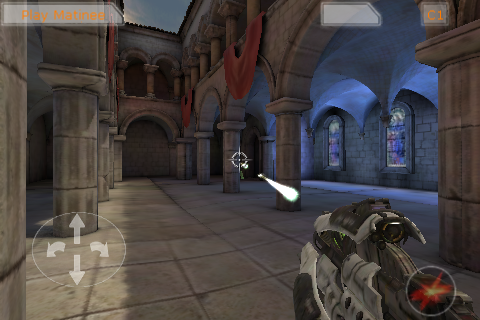Epic Demonstrates Unreal Engine 3 for the iPod Touch/iPhone 3GS
by Anand Lal Shimpi on December 22, 2009 12:00 AM EST- Posted in
- Smartphones
- Mobile
I got together with Mark Rein last week and he showed me an Unreal Engine 3 tech demo running on a 3rd generation iPod Touch. The same Unreal Engine 3 that powers Gears of War 2, running on an iPod Touch. The engine also works on the iPhone 3GS, and Mark tells me that we’ll see it on another mobile platform at CES (hmm...).
The demo is both playable and has a flythrough. It’s using a modified Unreal Tournament level previously shown off at GDC. A virtual thumbstick on the left side of the screen controls your movement, while tracking your thumb in the lower right corner of the screen controls the camera. Just tap the screen to shoot. Mark said this is a tech test bed and they’re experimenting with several different control schemes including ones with tilt.
In practice, the controls work well. This is just a demo so there was no score or point to the game, I just got to run around and kill a single respawning enemy. And it was fun.
As you can see from the video the frame rate was smooth. There are more visuals to be added, as well as some polishing, but the demo looked very good for an iPhone game.
It requires OpenGL ES 2.0, so the iPhone 2G and 3G won’t work, nor will the older iPod Touch models. It doesn’t really matter though, this is just a starting point.
Epic isn’t announcing any sort of iPhone engine licenses nor are they entering the iPhone game market. Porting UE3 to the iPhone is simply one of many projects being worked on inside a newer, more svelte and innovative Epic Games (wait till you see what’s next...).
Today the iPhone, Tomorrow the World
Mark said they planned to make this available to licensees at some point in the near future. That’s great for end users because it means that any Unreal Engine licensee can now start playing around with making iPhone games based on the same technology. Unfortunately the recently announced, free to the public, Unreal Development Kit (UDK) is Windows only - the iPhone version isn’t included. I’d guess that at some point Epic will change that, it just makes too much sense. Doing so would enable a whole new class of iPhone game development using an extremely polished engine.
It’s all about taking the portable market seriously. While I wouldn’t expect to see any Epic branded iPhone games anytime soon, eventually it wouldn’t be too far fetched to see a full port of Gears of War to something as small as an iPhone. NAND Flash capacities to support multiple 9GB games will be there in another few years, as will GPU horsepower.
Remember that the SoC in the iPhone 3GS is only built on 65nm technology, Intel is about to release its first 32nm chips. You could cram four times as many transistors into the same space at 32nm, roughly 9 times as many at 22nm. Remember that graphics performance scales very well with additional transistors. At what point does the smartphone become more powerful than an Xbox 360? Sometime in the next 3 - 5 years for sure.
And it’s not just about iPhone support. Mark told me that as soon as CES we’ll see Unreal Engine 3 on another mobile platform entirely. More announcements will happen throughout 2010. This isn’t a platform specific thing, it’s about bringing Unreal Engine 3 to the entire portable market.
Final Words
For the end user, Epic just improved the chances of getting better looking games on the iPhone and potentially other portable devices.

For Epic, expanding UE3 into the portable market makes a lot of sense - it will eventually increase the base of paying UE licensees as well as help move the entire portable gaming industry forward. It’s not all altruistic though, by releasing iPhone and other portable versions of UE3 it helps secure Epic’s position as a supplier of game engines, regardless of platform.
For an existing Unreal Engine licensee you now have the ability to compete in the growing iPhone market thanks to Epic, how nice. Once the phone gets powerful enough I expect it’ll be used for more than just playing simple games.
As personal computing moves to more platforms and takes new forms, what we need are technologies that unify development across all devices. There’s no reason that a game you’re writing for an iPhone shouldn’t be built on the same foundation as something you’re writing for a high end console. The difference should be in the game, not in the engine.
This latest move by Epic does validate whatever Apple has been quietly doing all along. From the investments in Imagination Technologies to hiring two previous AMD Graphics CTOs, Apple is clearly interested in gaming (which is funny given the poor state of gaming on the Mac).
Historically Apple likes to enter markets when it believes that it can do something better or at least different. We saw that with the iPhone. The question is, how does Apple plan on providing a different take on gaming?
The remaining hurdles are significant, but not unsurmountable. Playing anything other than a point and touch game on the iPhone can be frustrating. Epic doesn’t address that, but someone else surely will when the time is right.
Engine houses like Epic enable game developers to focus on building the game they want to build, not the underlying technology. With UE3 on the iPhone, we will eventually see more and hopefully better games on future versions of the platform. Not to mention whatever other mobile platforms Epic plans on porting UE3 to as well.













52 Comments
View All Comments
- Wednesday, December 23, 2009 - link
I'm really hoping the other platform would be Maemo. I've been playing with N900 for a month now and the HW&SW stack is just amazing. Because of this, Maemo would probably be the easiest platform for porting too.I think that is also the reason why Mozilla is bringing Firefox Mobile to N900 first.
felipecn - Tuesday, December 22, 2009 - link
The problem with Android is that almost everything should be programmed with Java. It's true that Google now allows to use some C/C++, but no one used it yet. And it's only to speed up apps, the graphical parts should use Java/Dalvik.While that, iPhone OS share the roots of Mac OS X. It's much easier to port something designed for a PC to the phone.
It's the same advantage Maemo has. It's a desktop Linux, but with a mobile interface.
Actually, it's even easier than iPhone OS. Just recompile and run (with screen state, memory and processing restrains).
Charbax - Tuesday, December 22, 2009 - link
It's just not true that Android is Java only. The Android Native SDK has been released 6 months ago and all the advanced apps are being prepared for release on the Android platform soon. Android devices runing ARM Cortex A8 can come with OpenGL ES 2.0 just as well. Unreal Engine comes for Android at CES most probably. It will look awesome on the Archos 5 Internet Tablet with Android with its superior 4.8" 800x480 screen that also outputs 1280x720 to a HDTV using the HDMI output.piroroadkill - Tuesday, December 22, 2009 - link
Stop reminding me how horrible Android is :(tali3san - Wednesday, December 23, 2009 - link
Yep... I've been trying to improve the graphics on an Android card game... basically higher resolution graphics for the Droid's screen (no point in having all those pixels if you don't use them right).I maxed out the heap space pretty quickly holding just prebuilt card images and some Illustrator built text and overlays exported at the right size for the screen.
I can't see many good games coming out for Android UNLESS Google allow someone to build an entire 3D graphics engine including the resource management in C++ and run that through Java (not using the Java heap space for resources).
Sigh.
djc208 - Tuesday, December 22, 2009 - link
I'm betting it's Android. The iPhone is a platform/os combo too. The market for Android is probably already larger than for Zune, especially since most people are probably thinking primarily of the ZuneHD only.If the Zune is easy to port to they may go there too, but I'm thinking there's a much larger potential market in Android than Zune. Especially because Android has not been limited to phones either. There are netbooks, and MIDs that have adopted it as well.
The only downside to Android is that the hardware isn't fixed like with the iPhone. Different Android phones can have different hardware specs, which like in PC games will change how well the system performs with a given app.
voodooboy - Tuesday, December 22, 2009 - link
I'm actually fairly confident that it is infact the Zune. Just like the iPhone/iPod, the Zune OS/hardware/software is a closed, tightly controlled eco-system...similar to the XBOX hardware/software/Live service. And this is infact very much UNLIKE the Android market, with 4 different versions of the OS floating around (1.5, 1.6, 2.0, 2.1), a variety of processors (ARM 11's, Cortex A8's, Snapdragons, Intel Atoms!), different form-factors/screen resolutions etc. It'll be a nightmare supporting such a fragmented platform. Also, most of the Android devices (non-Cortex/Snapdragon) do not, infact, support OpenGL 2.0ES.Apart from this, Microsoft and Epic have pretty close ties. Add in the fact that nVidia is looking seriously towards Tesla and Tegra to boost its revenue, they'd really want the UT3.0 engine running on the Tegra to be their poster-child.
MonkeyPaw - Tuesday, December 22, 2009 - link
Yeah, and game companies that use the Unreal engine already have well established ties to MS, so it should be relatively easy to get products into the market. Also, consider that PGR is already available for ZuneHD, so it seems like porting we be another source of revenue for current and old game titles.Lonyo - Tuesday, December 22, 2009 - link
[quote]NAND Flash capacities to support multiple 9GB games will be there in another few years, as will GPU horsepower.[/quote]I doubt that it will be 9GB when ported to a mobile platform :P
No point in having higher res textures, high poly models etc in a game when it's going to be rendered at a fairly low resolution. That 9GB game would become more like 2GB, which isn't that far off being feasible at current capacities.
MonkeyPaw - Tuesday, December 22, 2009 - link
"No point in having higher res textures, high poly models etc in a game when it's going to be rendered at a fairly low resolution."Agreed. Why will we ever need a phone to have as much power as a PS3 or 360? Most phones have very low resolutions, and most games today can be played at such resolutions on some pretty old hardware. Today's high-end phones are probably as powerful as the PS2 or Xbox, and the games for those consoles don't look too bad.